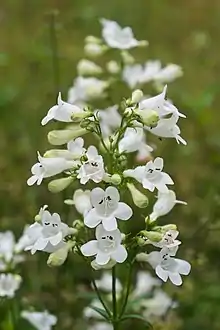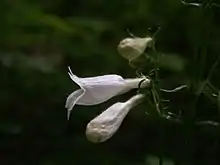Penstemon digitalis
Penstemon digitalis (foxglove beard-tongue,[1] foxglove beardtongue, talus slope penstemon,[2] or white beardtongue [3]) is a plant in the plantain family, Plantaginaceae. The flowers are white and are borne in summer. It is native to eastern Canada and eastern and southeastern United States.[1]
| Foxglove beard-tongue | |
|---|---|
 | |
| Inflorescence | |
| Scientific classification | |
| Kingdom: | Plantae |
| Clade: | Tracheophytes |
| Clade: | Angiosperms |
| Clade: | Eudicots |
| Clade: | Asterids |
| Order: | Lamiales |
| Family: | Plantaginaceae |
| Genus: | Penstemon |
| Species: | P. digitalis |
| Binomial name | |
| Penstemon digitalis Nutt. ex Sims | |
Description

Penstemon digitalis is a glabrous 3 to 5 foot tall herbaceous plant with opposite, shiny green, simple leaves, on slender, purple stems. The leaves are up to 5 inches long. While upright, the stems average anywhere from 2 to 3 feet tall. The flowering panicle extends to almost one third of the plant's height and has pairs of branches which repeat with two flowers multiple times. The pedicels are almost one fourth of an inch long and produce 1.25 inch long two-lipped tubular flowers over dark green foliage. The flowers have tiny white hairs on the outside of the tube. The plant has elliptic basal leaves and lance-shaped to oblong stem leaves.[4][5]
The Latin word digitalis means "finger-like": the flowers resemble fingers of a glove.[6] The plant grows in moist, sandy soil in full sun in meadows, prairies, fields, wood margins, open woods and along railroad tracks.[4][6] Its bloom period is from late spring to early summer. The plant is known to attract butterflies and birds such as hummingbirds. It tolerates deer browsing. Native states for P. digitalis include Iowa, Nebraska, and Missouri although it is less common in Iowan native prairies compared to other Penstemon species.[4][6]
Genome size
The genus Penstemon is the largest in North America with 270 species. However, genome size was relatively unknown for the species, which can be important for taxonomy. Scientists estimated the genome size for 40% of the species in the genus[7] using flow cytometry. Penstemon digitalis has one of the largest genomes of the genus Penstemon.
Gardens and cultivars
Like other Penstemon species, it is used in roadside planting because it is easily grown and showy.[4] It is recommended for easy use in gardens from the Midwest to the Atlantic coast and Pacific Northwest by the American Penstemon Society.[8] Iowa's Living Roadway Profiler from the Iowa Department of Transportation says that the plant's "decorative seed capsules add interest in the fall and winter".[4]
One of the plant's cultivars is named Husker Red because of its red foliage that has white or bluish-pink flowers. The Perennial Plant Association chose the Husker Red cultivar of Penstemon digitalis as the 1996 Perennial Plant of the Year. The author of the book Perennial All-Stars described Husker Red as "a stunning flowering perennial" and that "you can easily see why the Perennial Plant Association chose this perennial above all others". Husker Red was named after the Nebraska Cornhuskers.[9] The other cultivar, Mystica, is green at first and then later changes to red in the fall.[8]
Penstemon 'Dark Towers' is a hybrid between Penstemon digitalis 'Husker Red' and Penstemon 'Prairie Splendor' (which in turn is a hybrid of Penstemon cobaea and Penstemon triflorus).[10] The hybrid has tubular pink flowers that grow up to 1.5 inches tall, red foliage, and is 1.5 feet to 3 feet tall. Although Dark Towers is similar to Husker Red, its red foliage is darker than that of the Husker Red cultivar and has more height. It also stays red for a longer time in the summer. Dale Lindgren created and named both Husker Red and Dark Towers at the University of Nebraska in 1983.[11] Lindgren decided to create Husker Red because of its purplish-red foliage.[9]
References
| Wikimedia Commons has media related to Penstemon digitalis. |
- Dickinson, T.; Metsger, D.; Bull, J.; & Dickinson, R. (2004). ROM Field Guide to Wildflowers of Ontario. Toronto: Royal Ontario Museum, p. 332.
- "Penstemon digitalis". Natural Resources Conservation Service PLANTS Database. USDA. Retrieved June 9, 2017.
- Newcomb, L. (1977). Newcomb's Wildflower Guide. Little, Brown and Company, p. 102.
- Iowa's Living Roadway Profiler. Iowa Department of Transportation. p. 18.
- Addisonia: Colored Illustrations and Popular Descriptions of Plants, Volume 4. New York Botanical Garden. 1919. p. 19.
- "Penstemon digitalis". Missouri Botanical Garden. Retrieved June 9, 2017.
- Broderick, Shaun R.; Stevens, Mikel R.; Geary, Brad; Love, Stephen L.; Jellen, Eric N.; Dockter, Rhyan B.; Daley, Shawna L.; Lindgren, Dale T. (2011). "A survey of Penstemon'sgenome size". Genome. 54 (2): 160–173. doi:10.1139/G10-106. PMID 21326372.
- Rogers Clausen, Ruth (January 7, 2015). Essential Perennials. Timber Press. p. 300. ISBN 9781604696721.
- Cox, Jeff (October 25, 2002). Perennial All-Stars. Rodale. p. 240. ISBN 9780875968896.
- "US Patent for Penstemon plant named 'Dark Towers' Patent (Patent # PP 20,013 issued May 19, 2009)". Justia Patents Search. Retrieved 2019-05-30.
- "Penstemon 'Dark Towers'". Missouri Botanical Garden. Retrieved June 9, 2017.